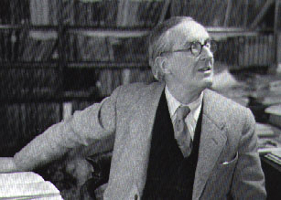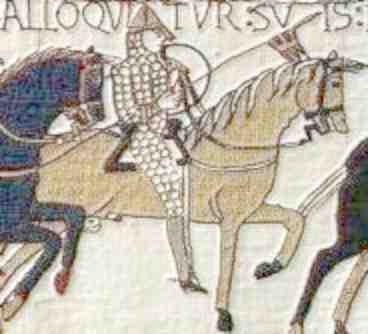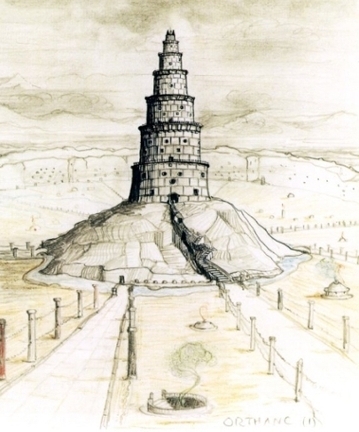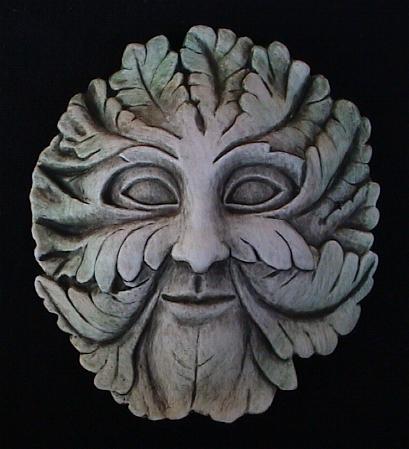Medieval Motifs in Books Three and Four
The author of Beowulf showed forth the permanent value of that pietas which treasures the memory of man's struggles in the dark past, man fallen and not yet saved, disgraced but not dethroned. It would seem to have been part of the English temper in its strong sense of tradition dependent doubtless on dynasties, noble houses, and their code of honour, and strengthened, it may be, by the more inquisitive and less severe Celtic learning, that it should, at least in some quarters and despite grave and Gallic voices, preserve much from the northern past to blend with southern learning, and new faith.
--"The Monsters and the Critics"

This passage from Tolkien's lecture is suggestive of an attitude he took in The Lord of the Rings. Indeed, it may describe his own Roman Catholicism looking into the Northern (and pagan) past. Tolkien's major work can be said to be the "English" mixture of Gallic and Celtic voices he so prized, a mixture of Christianized medievalism and the strong flavor of a past still informed by natural religion and its ethic. Some of the following motifs give evidence for such a claim:
Redemption in Death
Quite soon we are to meet our promised end;
we won't remain alive beyond today;
however, I assure you of one thing:
that holy Paradise stands there for you,
and you'll be seated near the Innocents.
--Song of Roland 115
- Does Boromir's death in defense of Merry and Pippin redeem his earlier actions?
- Is it a "Christian" warrior's death? Is it partially salvific?
- What is Boromir valued for and how is he regarded by Aragorn, by Pippin, and by his brother Faramir?
- What does Faramir's last sighting of Boromir suggest about the warrior's life and death?
The Hunt and The Riddles
I was once a warrior's weapon.
Now a noble young retainer
dresses me in threads of twisted gold
and silver. At time men kiss me,
at times I summon close friends
to do battle; a horse sometimes bears me
over the earth, sea-horses sometimes
sweep me, gleaming, over the ocean;
now and then a maiden, ring-adorned,
replenishes my paunch. I must lie on planks
at times, plundered, hard and headless;
often, gold-garbed, I hang on the wall
above drinking warriors, a splendid sight,
instrument of war. Covered in riches,
I draw in breath from a brave man's lungs
when retainers ride towards battle.
At times I tell proud warriors
that wine is served; at times rally them,
save booty from hostile men, drive off
the enemy. Now ask me my name.
--Exeter Book, Riddle 14 (answer: a horn)
- What is the purpose of the hunt that Aragorn, Legolas, and Gimli undertake? What does it accomplish?
- How does the motif of the riddle act to unify the various narrative actions in Book 3?
- What forms of access to the narrative answers does Tolkien give his readers that the characters themselves do not have?
- Can the answer to narrative riddles be understood as a metaphor for providence?
Legends Alive
- Another dominant motif in Book 3 is that of legends that have come alive. What kinds of purposes do encounters with things formerly thought legendary serve in the text?
- What do these encounters suggest about the nature of the land of Rohan?
- Would it be appropriate to describe Aragorn as an Arthurian figure?
The Anglo-Saxon (or Gothic) Rohirrim
"Shake yourself out of this parochialism of time! Also (not to be too donnish) learn to discriminate between the bogus and genuine antique--as you would if you hoped not to be cheated by a dealer!"
--draft of a letter to Hugh Brogan, Sept 1955

Tolkien intentionally gives a number of Anglo-Saxon (or perhaps quasi-Gothic) attributes to Rohan, including speech patterns, words with Old English origins, and cultural conventions. He also borrows directly from Beowulf for several characters and scenes.
- What impression does the overall narrative give of the Rohirrim as a people?
- Do the Rohirrim serve as a commentary on the Anglo-Saxon culture? What do they suggest about it?
- Why does Tolkien deliberately echo Beowulf in the approach to the guard and in Hama, the doorwarden? (631ff/ III.vi)
- How does Tolkien adapt Unferth to Wormtongue?

The Theory of Courage
"Byorthwold spoke; he grasped his shield; he was an old companion; he shook his ash spear; full boldly he exhorted the warriors: 'Thought shall be the harder, heart the keener, courage the greater, as our might lessens. Here lies our leader all hewn down, the valiant man in the dust; may he lament for ever who thinks now to turn from this war-play. I am old in age; I will not hence, but I purpose to lie by the side of my lord, by the man so dearly loved."
--The Battle of Maldon (trans. R.K. Gordon)
- How do Frodo and Sam exemplify the northern "theory of courage"? (793/ IV.iii; 915-16, 22/ IV.x; )
- Why would Tolkien give them this role? Is it heroic?
- How else is this attitude manifest in LOR?
Trouthe, Comitatus, and Treachery
trouthe: truth, fidelity, faith, (plighted) word, troth, compact, honesty, equity
comitatus: the loyalty and love owed by a vassal to his lord; in turn, the love and protection owed by a lord to his vassal.
- In what ways is the complex medieval concept of trouthe exemplified in Frodo's treatment of Gollum? How is it present between Sam and Frodo? Between Frodo and Faramir?
- What makes Gollum's internal struggle so important in this light?
- Why would Tolkien describe Sam's naming of Smeagol as a "sneek" as "tragic"? (Smeagol is taken from the Old English smygel or "burrow; "thus, with the sense of one who hides and deceives.)
- Is trouthe and/or comitatus present in the relationship of other characters?
Wisdom, Service (Stewardship), and Power
These three themes exemplify one of the larger, intertwined patterns of The Lord of the Rings, as well as the way their mirror-opposites can be expressed in the same concept. The wise are those who have the ability to guide and understand how to act in an area of life, so the wise may or may not be also good, i.e. Saruman versus Gandalf. Service can be demanded or freely offered--it can be the modernistic military tyranny of Saruman and Sauron's orcs or it can be the justly fulfilling place of Sam in service to Frodo his master. Power can be used for the good, manipulated for the evil, or laid down as a sacrifice.
- How are these three themes contrasted in Saruman and Gandalf?
- How are they contrasted in Éomer and Wormtongue?
- How are they contrasted in Boromir and Faramir?
- What do they reveal about Sam's self-understanding?
The Interlace Structure (Richard C. West)
Richard C. West in his influential article "The Interlace Structure of The Lord of the Rings" argues that medieval interlace seeks to achieve some of the following qualities:
- "[It] mirrors the perception of the flux of events in the world around us, where everything is happening at once."
- "Its narrative line is digressive and cluttered. . . and is often indifferent to cause and effect relationships."
- "The paths of characters cross, diverge, and recross, and the story passes from one to another and then another but does not follow a single line."
- "Also, the narrator implies that there are innumerable events that he has not had time to tell us about."
- Yet "no part of the narrative can be removed without damage to the whole, for within any given section there are echoes of previous parts and anticipations of later ones."
- "Moreover, though events are in flux there is a pattern underlying them."
- "The effect of what might be called open-endedness, whereby the reader has the impression that the story has an existence outside the confines of the book and that the author could have begun earlier or ended later."
Which of these characteristics is present in The Lord of the Rings, especially in Books 3 and 4? How does Frodo and Sam's discussion of being in the tale reflect this phenomena? (886-887/ IV.viii) What about other requests by characters to "have the tale in full"?

The Presence of Place--Ithilien and Cirith Ungol
Like Fangorn, Helm's Deep, or the Dead Marshes, Ithilien and Cirith Ungol have a particularizing quality about them, where their natural setting is tied to their inhabitants. Just as "Treebeard" is Fangorn Forest, so the healing qualities of Ithilien are tied to the wisdom and discernment of Faramir, and so is the ghastly corpse-like quality of Cirith Ungol tied to Shelob.
Compare the following passages: 786 (IV. ii); 809-810 (IV.iv); 876 (IV.viii).
What do they suggest about the physical and moral landscapes?
